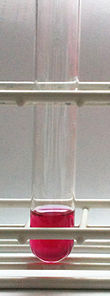Voges-Proskauer reaction
With the Voges-Proskauer reaction , bacterial cultures are tested for the formation of acetoin (3-hydroxy-2-butanone, acetylmethylcarbinol), which in an alkaline environment with creatine (contained in the peptone of the nutrient medium or as an additive after incubation) is intensified causes a red coloration by α-naphthol . This test is used to differentiate and identify bacteria, especially Enterobacteriaceae, and is a component of the so-called IMViC reactions, which allow extensive differentiation as part of the so-called colorful series or in the form of commercial test systems such as the Analytical Profile Index .


The Enterobacteriaceae can be divided into two groups with regard to their fermentation products. That is, for one of the Escherichia coli type, predominantly various organic acids from glucose forms - in the mixed acid fermentation - and on the other of the Enterobacter -type of glucose in the 2,3-Butandiolgärung especially butanediol (and acetoin as Intermediate product) as well as gas (CO 2 and H 2 ) forms, but only a little acid. The formation of acid is detected with the methyl red test (also called MR test), while the formation of acetoin as a precursor of 2,3-butanediol can be demonstrated in the Voges-Proskauer test (also abbreviated as VP test).
For example, the bacteria of the genera Enterobacter , Klebsiella and Serratia in the 2,3-Butandiolgärung of glucose 2,3-butanediol and acetoin as an intermediate. With them, the Voges-Proskauer reaction is positive. They are in contrast to other genera of the Enterobacteriaceae , such as. B. Escherichia , Proteus , Citrobacter , Salmonella and Shigella , which do not form acetoin and for which the Voges-Proskauer reaction is therefore negative. It should be noted that this is a rough categorization; individual species of a genus may show different results. When identifying at species level with the help of miniaturized test systems, a percentage table, for example, is used as an aid in the evaluation, which indicates the percentage of the tested representatives of a species for which a certain reaction was positive or negative.
literature
- Otto Voges , Bernhard Proskauer : Contribution to nutritional physiology and the differential diagnosis of the bacteria of hemorrhagic septicemia. In: Journal of Hygiene and Infectious Diseases. Vol. 28 (1898), Issue 1, pp. 20-32, doi : 10.1007 / BF02285362 .
- Max Levine: On the Significance of the Voges-Proskauer Reaction. In: Journal of Bacteriology. Vol. 1 (1916), No. 2, pp. 153-164, PMID 16558690 .
Individual evidence
- ↑ a b Roland Süßmuth, Jürgen Eberspächer, Rainer Haag, Wolfgang Springer: Biochemical-microbiological internship. 1st edition. Thieme Verlag, Stuttgart / New York 1987, ISBN 3-13-685901-4 .
- ↑ a b c Hans G. Schlegel: General microbiology. 7th edition. Thieme Verlag, Stuttgart / New York 1992, ISBN 3-13-444607-3 .
- ↑ a b Michael T. Madigan, John M. Martinko, Jack Parker: Brock Mikrobiologie. German translation edited by Werner Goebel, 1st edition. Spektrum Akademischer Verlag GmbH, Heidelberg / Berlin 2000, ISBN 978-3-8274-0566-1 .